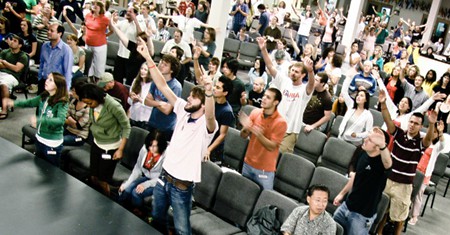Click to join the conversation with over 500,000 Pentecostal believers and scholars
Click to get our FREE MOBILE APP and stay connected
| PentecostalTheology.com



So you entered into church leadership full of enthusiasm and fresh ideas.
And for a season, a lot of those ideas worked.
You saw your ministry grow, people come to faith and the mission advance.
But times change.
And—these days especially—culture is changing faster than ever before.
As a result, the shelf life of ideas, assumptions and approaches is shorter than it has ever been.
What used to work, doesn’t. Not anymore.
The challenge is to know what’s stopped working and what hasn’t.
Not everything that worked a decade ago in the church was great. But the truth is many churches saw growth anyway.
And that’s changing and will continue to change.
What got you here won’t get you there.
Here are 9 things that used to work in ministry a decade ago that aren’t nearly as effective as they used to be.

1. RELYING ON AN AUTOMATIC RETURN TO CHURCH
There was a day when you could fairly safely assume that once young adults got married and had a child, they would automatically come back to church.
Those days are gone or largely gone. (You can catch more about what’s changed in Episode 24 of my podcast where I interview David Kinnaman, President of Barna Group).
The average unchurched person doesn’t think about going to church anymore than the average Christian thinks about going to synagogue. It just doesn’t cross their mind.
Having an exceptional next generation ministry that reaches out to the community is critical.
Want a better way to impact families? I know of no better approach than this.
The Orange strategy is the strategy we use, and our kids’ ministry is the fastest growing ministry at our church.
You can’t assume families will reach out to you, so you need to reach out to them.
2. APPEALING TO PEOPLE OUT OF GUILT OR OBLIGATION
The number of people who feel guilty about not being in church on Sunday shrinks daily.
Ditto with the number of people who will serve at a church because they feel they should.
Interestingly enough, Jesus never appealed to people out of guilt or obligation. He invited people.
The future church will as well.
3. SIMPLY BEING BETTER THAN OTHER CHURCHES
When people went to church, being a better church than other churches got you mileage.
Most people no longer go to church.
Saying “we have a better church” is kind of like saying “we have better, organic, locally grown watercress” at a burger cook-off.
Most people just aren’t going to buy.
Better isn’t going to get you the mileage it used to.
Different will.
The church is an alternative. And an alternative, clearly and effectively presented, will do far better than simply saying we’re better than something you weren’t interested in in the first place.
4. GIMMICKS
So true confession. A decade ago we drove a car on stage to get people’s attention.
We also built elaborate sets for every series hoping it would captivate people.
And all of this did. For a season.
But I also came to realize that whatever you use to attract people is what you need to use to keep people.
‘Gimmicks’ every week get old fast.
If you play the ‘next Sunday will be better than last Sunday game,’ you eventually end up losing and lying (because it can’t be).
In addition, eventually people ask “So what? So what if next Sunday is a little bit better than last Sunday? What’s this all about anyway?”
Don’t get me wrong. We still have fun moments, powerful moments, surprising moments and memorable moments, but they’re moments.
We’ve stripped down our services and moved back to more of the basics: the Gospel, engaging moments and engaging messages.
We can sustain that. And the basics, done really well (with a little extra from time to time) really do engage people.
Why? Because Jesus, authentically and clearly presented, engages people.
5. INAUTHENTIC LEADERSHIP
People’s fake detectors are set at a higher level than ever.
In a culture that markets everything to death, people are longing for authenticity.
Fortunately, that’s the at the heart of the Gospel.
What has to die, of course, is the leader who acts like he or she has it all together: the plastic veneer we put on hoping nobody sees the real us.
Well, none of us has it all together. And while there shouldn’t be any gaping unaddressed character holes in your life, letting people see the real you (even if it scares you) is essential.
These days, letting people see you’re human is a prerequisite for ministry to fellow humans.
6. A SELF-CENTRED MISSION
You have to be careful not to make the mission about your church.
When your church has had a little success, it’s easy to become self-centred.
The people you’re trying to reach aren’t interested in your church.
What they’re interested in (whether they realize it or not) is Jesus. And his mission.
Churches that are obsessed about how big they are, how many programs they offer, and how much better they are than other churches have a limited shelf-life.
The true mission isn’t about your church. It’s about THE church. THAT resonates.
7. RANDOM PROGRAMMING
The bigger your church, the more you will be tempted to add programs and ministries.
Why?
Because people demand them.
Leaders—afraid to disappoint people or lacking an alternative strategy—cave and allow dozens (or hundreds) of random programs to emerge in their church.
These programs can be counter-productive for numerous reasons:
They compete for money, time and attention.
They lead nowhere in particular.
They cause more division than unity (ever try to shut down a women’s ministry or men’s breakfast?).
They become their own mission and compete with the overall mission of the church.
Why does random programming not work?
Simple: because random programming pleases insiders but rarely reaches outsiders.
Instead, be strategic and focused. Do whatever helps move people the most clearly and deeply into a growing relationship with Jesus, and do whatever advances your mission into the city.
Make no mistake: What people become involved in becomes the mission. So choose carefully.
Make the mission your mission.
8. ASSUMING PEOPLE KNOW WHAT THEIR NEXT STEP IS
A decade ago, in a more churched culture, it was commonplace to assume that most people knew what they needed to do to become a Christian or to grow as a Christian.
That era is gone.
Now the average unchurched person arrives knowing almost nothing about Christianity, what to do to become a Christian or how to grow as a Christian.
To understand how radically things have shifted, imagine you converted to Hinduism.
How would you know you’ve actually become a Hindu?
What’s your next step?
Exactly.
Just remember that the next time a completely unchurched person begins to attend your church.
At Connexus Church, where I serve, we reorganized our approach to new people around two key phrases: “I’m New” “Take a Step”.
We’re doing everything we can to ensure people understand how to become a Christian, how to engage in spiritual growth and what steps they can take to help them grow.
We even set up two hosted kiosks in the foyer under the phrases “I’m New” and “Take a Step”. Our trained guest services people help orient guests around what step might be best for them to take next.
Leaders, if you’re not clear, no one else is clear either.
9. RELYING ON WHAT YOU’VE LEARNED IN THE PAST
I suppose at one time there was a day when seminary adequately trained church leaders for what was ahead.
That day has long since passed.
The basics—biblical knowledge, theology and the likes—don’t change dramatically. And shouldn’t. That foundation is reliable years, even decades later.
But there’s a growing gap between what leaders need to know about the culture and what they actually know.
Some seminaries are catching up, but with change happening faster than ever, every leader needs to become a self-learner.
So how do you keep up?
Here are three ways I keep up and try to help you stay current, both as a fellow learner and a content creator.
1. Podcasts
200 episodes ago, I started a Leadership Podcast…largely because the conversations I was having with key leaders were changing how I approached leadership and ministry.
First, I wanted everyone to be able to hear what key leaders were telling me. And second, I wanted an excuse to have more great conversations with key leaders. Hence, the podcast.
You can subscribe to my leadership podcast for free on Apple Podcasts . It’s an interview format in which I interview top leaders about church trends on a weekly basis to stay sharp personally, but also to help you.
2. Conferences And Courses
Conferences that really dissect practical leadership are also essential.
Rethink Leadership is a brand new conference in Atlanta I’ll be a part of in Atlanta in May 2019. It’s a two day intimate, senior leaders-only gathering with today’s top business and church leaders.
Can’t wait to get to a conference?
I’ve also developed three online, on-demand courses that can help you navigate the complexities of ministry and leadership:
The Art of Better Preaching walks you through 12 ways to anchor and improve your preaching content, writing and even delivery.
Church Growth Masterclass will help you eliminate the things that keep your church from growing and implement some strategies that will help you reach far more people.
The High Impact Leader will help you beat overwhelm and get time, energy and priorities working in your favour.
3. Current Reading
I read a lot of books. Many are timeless in nature (great leadership is). But there are also few can help you digest changing trends in leadership.
That’s exactly why I wrote my latest book, Didn’t See It Coming: Overcoming the 7 Greatest Challenges Everyone Experiences and No One Expects. It will help you navigate the personal issues that plague so many leaders: things like cynicism, compromise, disconnectedness and more.
Brian Houston and Andy Stanley call Didn’t See It Coming ‘powerful.’ Nancy Duarte says it’s a book that ‘pierces the heart.’ Ann Voskamp’s take? “You have to read this book.” And Jud Wilhite says “Seriously, this may be the most important book you read this year.”
You can learn more and get your copy of Didn’t See It Coming here.
Bottom line?
However you decide to stay current, you have to stay current.
WHAT’S NOT WORKING FOR YOU?
So let’s help each other. What’s no longer working for you that used to work?
Scroll down and leave a comment.



RichardAnna Boyce
surely an unconditional Gospel of Free Grace is the only message that will work. 2 Corinthians 3:9 For if the ministry that brings condemnation [the old covenant, the Law] has glory, how much more does glory overflow in the ministry that brings righteousness [the new covenant which declares believers free of guilt and sets them apart for God’s special purpose]!
Varnel Watson
I am looking for #10 Michael Ellis Carter Jr.
Varnel Watson
RELYING ON AN AUTOMATIC RETURN TO CHURCH
There was a day when you could fairly safely assume that once young adults got married and had a child, they would automatically come back to church.
Those days are gone or largely gone. (You can catch more about what’s changed in Episode 24 of my podcast where I interview David Kinnaman, President of Barna Group).
The average unchurched person doesn’t think about going to church anymore than the average Christian thinks about going to synagogue. It just doesn’t cross their mind. https://podcasts.apple.com/us/podcast/carey-nieuwhof-leadership/id912753163?mt=2
Varnel Watson
have we seen this before? Michael Ellis Carter Jr.